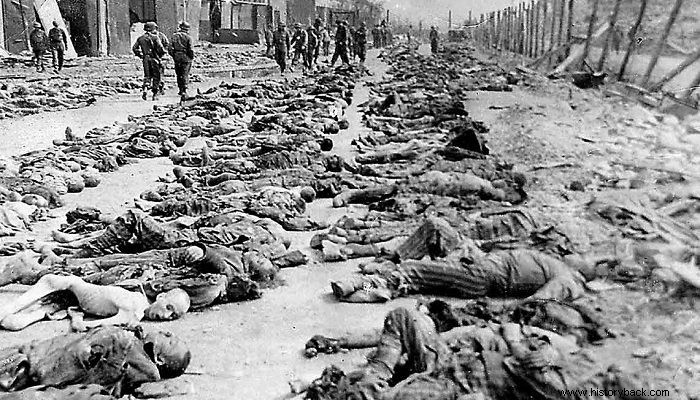
Soldiers of the US 7th Army's "Rainbow Division" advance from Wurzburg into the German south. On the morning of April 29, 1945, they arrive at the closed gates of a concentration camp near Munich, Dachau. The Wehrmacht men have long since retreated, the SS have put it to rest. This was the situation when the American soldiers entered the camp.
The picture they see cannot be described in words. Hundreds of corpses on wooden stilts and open train cars, everywhere half-dead skeletons incarcerated with the obvious signs of typhoid, only a few could stand on their feet. But there was also a group of prisoners, somewhat stronger, who since the beginning of April had formed a secret resistance group in the chaos of the overcrowded prisons. And when the Americans entered and systematically searched every corner of the camp, they told them that they were members of the International Prisoners' Committee.
Ashes from burnt human flesh
“Behind barbed wire and electric cables, skeletons sat in the sun looking for lice. You couldn't distinguish ages and faces, they all looked the same" wrote the American Martha Gellhorn, who since October 1944 followed the American forces in Nazi-occupied Europe as a war reporter. At the beginning of May 1945 he entered the Dachau concentration camp for the first time. With the first round he experienced the absolute shock.
“We crossed the camp from one end to the other between the prisoners' barracks and entered the mobile hospital. There were other skeletonized people sitting in the corridor. The smell of disease and death was everywhere. The prisoners watched us motionless, no expression on their yellow, bony faces." Gellhorn was the wife of famed author Ernest Hemingway, who she married in 1941 not so much because she was in love with him as because she admired him. From the beginning of the Spanish Civil War 1937/1938 he reported for major American newspapers mainly from the world theaters of war.
Martha Gellhorn was born to be a war correspondent and followed the movements of the American army in Europe as a kind of embedded journalist, as we would say today. In May 1945 he entered the liberated Dachau. "What killed most was hunger, extermination by hunger" was her conclusion from her shocking first impressions and conversations with prisoners. "People worked excruciatingly with little food, and in the crowded barracks every morning they woke up one step closer to death".
Since 1933, 200,000 prisoners have passed through the camp. "No one knows how many of them in twelve years found death, but we know that in the last three years there were at least 45,000" the American journalist wrote in her reports. Her investigations in April and May 1945 about the inhumane conditions in Dachau, the Third Reich and the facts in numbers shock the seasoned reporter to such an extent that she cannot help but be a bit cynical.
"In front of the crematoria, separated by a strip of green, there was a row of well-built and spacious houses, where SS officers lived with their families, women and children, happy and peaceful, while from the chimneys of the crematoria came ashes of burnt human flesh. In February and March 1945, 2,000 were exterminated in the crematoria, because they were too weak to work and did not do the SS the favor of dying. So the SS did it for them".
A model concentration camp
Dachau was the first Nazi concentration camp. By order of Heinrich Himmler, Minister of the Interior and Chief of the German Police, it was built very close to the polychine of the same name for 5,000 male prisoners. This particular camp became a model for what was to come, even the Auschwitz/Birkenau extermination camp, thanks to its first commandant, Theodor Icke, a fanatical Nazi and SS officer. The wooden stalls were built along long corridors, between which there was room for SS guards' invitations.
The first prisoners in Dachau were political prisoners, opponents of the regime, trade unionists, social democrats, communists, homosexuals but also partly conservative politicians. Later criminals, Jehovah's witnesses, Sindi and Roma, politically active Christians and Jews followed. Ike with military training and with inhuman severity trained the SS guards in torture, in the use of inhuman violence and taught them methods of extermination. "I only need hard and determined SS men, soft ones have no place with us", he said.
When on the morning of April 29, 1945 the prisoners crawled into the convocation area, they were surprised to see that the SS, on one of the watch towers, had raised a white flag. A large number had left the camp and taken the road of flight. Those who remained tried with machine guns to keep the prisoners under control. Rumors that something was about to happen spread like wildfire. It was also the penultimate camp liberated by the allied forces.
Memorial for the dead of the camp
Monument to the dead of the camp
On April 30, 1945, the Americans entered Munich, where the Nazis, with the Führer's building and the headquarters of the Nazi National Socialist Party NSDAP, had established the "Capital of the Movement", as they characteristically called it. A little later information leaked that Hitler and Eva Braun committed suicide in the bunker in Berlin. The last transfers of prisoners from the camp in Mildorf, near Munich, took place in early May by American soldiers. On May 8, Nazi Germany surrendered unconditionally, the war was finally over.
SOURCE:DW
